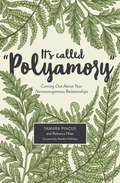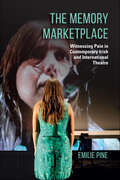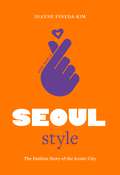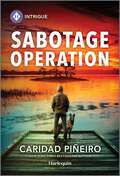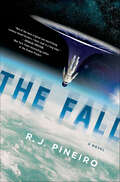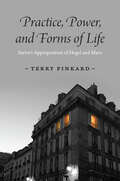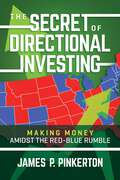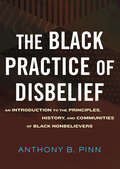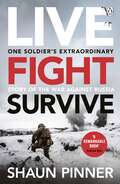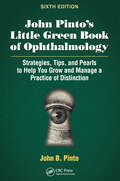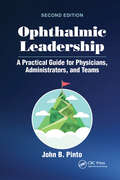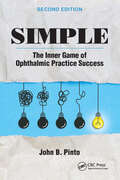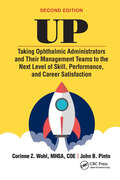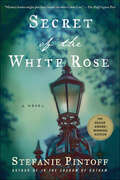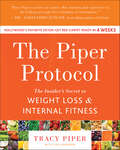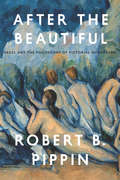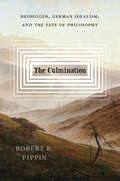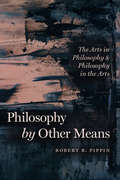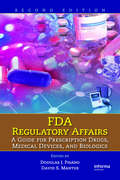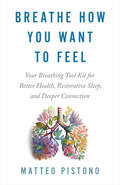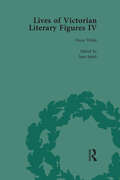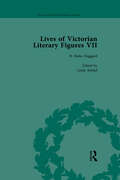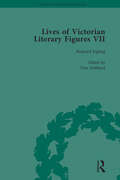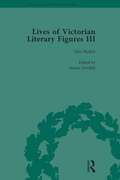- Table View
- List View
It's Called "Polyamory": Coming Out About Your Nonmonogamous Relationships
by Tamara Pincus Rebecca HilesEven in progressive families and communities, people who practice nonmonogamy are susceptible to misinformation and accusations of moral and emotional failings. Facing this requires its own coming out and education process. In this guide, Tamara Pincus and Rebecca Hiles provide a roadmap for explaining the expansive intricacies of the consensual nonmonogamy spectrum. By fusing personal experience and community research, they break down the various incarnations of polyamorous relationship structures, polyamory's intersections with race and gender, and the seemingly esoteric jargon of the lifestyle.Topics include everything from how to explain what a "unicorn hunter" is to answering questions like, "Can poly people raise children?" and "Can they live normal, healthy lives?" Such conversations are eloquently explained and the real dangers of being out as poly in a monogamy-centered society are laid bare.
The Memory Marketplace: Witnessing Pain in Contemporary Irish and International Theatre (Irish Culture, Memory, Place)
by Emilie PineWhat happens when cultural memory becomes a commodity? Who owns the memory? In The Memory Marketplace, Emilie Pine explores how memory is performed both in Ireland and abroad by considering the significant body of contemporary Irish theatre that contends with its own culture and history. Analyzing examples from this realm of theatre, Pine focuses on the idea of witnesses, both as performers on stage and as members of the audience. Whose memories are observed in these transactions, and how and why do performances prioritize some memories over others? What does it mean to create, rehearse, perform, and purchase the theatricalization of memory? The Memory Marketplace shows this transaction to be particularly fraught in the theatricalization of traumatic moments of cultural upheaval, such as the child sexual abuse scandal in Ireland. In these performances, the role of empathy becomes key within the marketplace dynamic, and Pine argues that this empathy shapes the kinds of witnesses created. The complexities and nuances of this exchange—subject and witness, spectator and performer, consumer and commodified—provide a deeper understanding of the crucial role theatre plays in shaping public understanding of trauma, memory, and history.
Little Book of Seoul Style: The Fashion History of the Iconic City (Little Books Of City Style Ser.)
by Dianne Pineda-KimFashion rules supreme in Korea with Seoul fast gaining its reputation as East Asia's leading style capital. From hanbok to hallyu, understated to experimental, and streetwear to high-end couture, Little Book of Seoul Style is a beautifully illustrated guide to the traditions, designers, subcultures and influencers that represent K-fashion on the global style stage.
Little Book of Seoul Style: The Fashion History of the Iconic City (Little Books Of City Style Ser.)
by Dianne Pineda-KimFashion rules supreme in Korea with Seoul fast gaining its reputation as East Asia's leading style capital. From hanbok to hallyu, understated to experimental, and streetwear to high-end couture, Little Book of Seoul Style is a beautifully illustrated guide to the traditions, designers, subcultures and influencers that represent K-fashion on the global style stage.
Sabotage Operation (South Beach Security: K-9 Division #1)
by Caridad PiñeiroA security expert and his K-9 Will protect a stable owner at any costOwner of a thoroughbred racing stable, Teresa Rodriguez is about to testify against her former trainer. Is he the one behind all the recent sabotage? When security expert Matt Perez joins the investigation, Teresa is grateful for the extra protection he and his K-9 offer. Now, as Matt and his dog, Butter, stand beside her 24/7, the attraction between them can&’t be denied. Even as the danger escalates.From Harlequin Intrigue: Seek thrills. Solve crimes. Justice served.Discover more action-packed stories in the South Beach Security: K-9 Division series. All books are stand-alone with uplifting endings but were published in the following order: Book 1: Sabotage OperationBook 2: Escape the Everglades
The Fall: A Novel
by R. J. PineiroIn R. J. Pineiro's The Fall, a sci-fi thriller, a man jumps from the upper-most reaches of the atmosphere and vanishes, ending up on an alternate Earth where he died five years earlier.Jack Taylor has always been an adrenaline junkie. As a federal contractor, he does dangerous jobs for the government that fall out of the realm of the SEALS and the Marines. And this next job is right up his alley. Jack has been assigned to test an orbital jump and if it works, the United States government will have a new strategy against enemy countries.Despite Jack's soaring career, his personal life is in shambles. He and his wife Angela are both workaholics and are on the verge of getting a divorce. But the night before his jump, Jack and Angela begin to rekindle their romance and their relationship holds promise for repair. Then comes the day of Jack's big jump. He doesn't burn up like some predicted—instead, he hits the speed of sound and disappears. Jack wakes up in an alternate universe. One where he died during a mission five years earlier and where Angela is still madly in love with him. But in this world, his boss, Pete, has turned to the dark side, is working against him, and the government is now on his tail. Jack must return to his own world but the only way for him to do that is to perform another orbital jump. This time is more difficult though—no one wants to see him go.Jack's adrenaline is contagious—The Fall will keep readers on the edges of their seats, waiting to find out what crazy stunt Jack will perform next and to learn the fate of this charming, daredevil hero.
Practice, Power, and Forms of Life: Sartre’s Appropriation of Hegel and Marx
by Terry PinkardPhilosopher Terry Pinkard revisits Sartre’s later work, illuminating a pivotal stance in Sartre’s understanding of freedom and communal action. Jean-Paul Sartre’s Critique of Dialectical Reason, released to great fanfare in 1960, has since then receded in philosophical visibility. As Sartre’s reputation is now making a comeback, it is time for a reappraisal of his later work. In Practice, Power, and Forms of Life, philosopher Terry Pinkard interprets Sartre’s late work as a fundamental reworking of his earlier ideas, especially in terms of his understanding of the possibility of communal action as genuinely free, which the French philosopher had previously argued was impossible. Pinkard reveals how Sartre was drawn back to Hegel, a move that was itself incited by Sartre’s newfound interest in Marxism. Pinkard argues that Sartre constructed a novel position on freedom that has yet to be adequately taken up and analyzed within philosophy and political theory. Through Sartre, Pinkard advances an argument that contributes to the history of philosophy as well as key debates on action and freedom.
The Secret of Directional Investing: Making Money Amidst the Red-Blue Rumble
by James P. PinkertonTo know the trend, spot the trend, or shape the trend is to make money.The trend is your friend—investors know that. But the biggest money comes from the biggest events. The more delta, the more alpha.In that spirit, The Secret of Directional Investing offers a new way of thinking about investing, steeped in culture and history. Focusing on megatrends, this book points out ways to profit from an understanding of two kinds of trends: those that can be spotted, and those that can be shaped. There&’s money in both. The Romans weren&’t kidding when they said, Audentes Fortuna luvat—Fortune favors the bold. The Secret of Directional Investing is a bold look at investments and potential investments.
The Black Practice of Disbelief: An Introduction to the Principles, History, and Communities of Black Nonbelievers
by Anthony PinnA short introduction to Black Humanism: its history, its present, and the rich cultural sensibilities that infuse itIn the United States, to be a Black American is to be a Black Christian. And there&’s something to this assumption in that the vast majority of African Americans are Christian. However, in recent years a growing number of African Americans have said they claim no particular religious affiliation—they are Black "nones." And of these Black "nones," the most public and vocal are those who claim to be humanists.What does it mean to be a Black humanist? What do Black humanist believe, and what do they do? This slim volume answers these questions. Animated by six central principles, and discussed in terms of its history, practices, formations, and community rituals, this book argues that Black humanism can be understood as a religious movement. Pinn makes a distinction between theism and religion—which is simply a tool for examining, naming, and finding the meaning in human experience. Black humanism, based on this definition isn&’t theistic but it is a religious system used to explore human experience and foster life meaning. It infuses humanism with rich cultural sensibilities drawn from Black experience. As shown in these pages, thinking about Black humanism this way frees readers from making unfounded assumptions and enables them to better appreciate the secular &“beliefs,&” ritual structures, and community formation constituted by Black humanists.
Live. Fight. Survive.: An ex-British soldier’s account of courage, resistance and defiance fighting for Ukraine against Russia
by Shaun PinnerREAD FORMER BRITISH ARMY SOLDIER SHAUN PINNER’S EXTRADORDINARY FIRST-HAND ACCOUNT OF THE WAR IN UKRAINEFor fans of Bravo Two Zero, Touching the Void, and No Way Out‘A hell of a story’ Sgt Dan Mills, Sniper One‘A remarkable book’ Andrew Marr----‘Live. Fight. Survive,’ she said. So, he did . . .There are just two places Shaun Pinner has felt most at home: first, during his nine years in the British Army and, second, in Ukraine, where he settled after marrying. It was only natural then, that when Russia invaded Ukraine in 2022, he was on the front line leading a section of marines.Outnumbered and outgunned, Pinner's troops staged a fighting retreat to Mariupol for that remarkable, defiant last stand against Putin’s war machine. But this was just the beginning of Shaun’s ordeal. When his troops were ambushed, Shaun was captured – and his war shifted from the battlefield to the interrogation room, when the real fight for survival began . . .---‘A remarkable story from the frontline. Extraordinary descriptions [of] what it's actually like to be in a trench fighting in the winter on the front line against the Russians’ ANDREW MARR‘An extraordinary real-life story’ ENTERTAINMENT FOCUS‘I was mesmerised. Unforgettable’ COLONEL RICHARD KEMP, CO-AUTHOR OF ATTACK STATE RED
John Pinto’s Little Green Book of Ophthalmology: Strategies, Tips and Pearls to Help You Grow and Manage a Practice of Distinction
by John B. PintoThe classic reference text for surgeons and managers alike that has been improving ophthalmic practices for decades, John Pinto’s Little Green Book of Ophthalmology: Strategies, Tips, and Pearls to Help You Grow and Manage a Practice of Distinction, Sixth Edition, has been updated into a new edition. Author John B. Pinto, a world-renowned expert on the business of ophthalmic practice, has brought his decades of expertise to bear in this comprehensive guide to practice management. Inside, Pinto covers everything from the basics of business planning to esoteric and complex topics unique to ophthalmology. Topics include: Strategic business planning Leadership, governance, and discipline Finance, accounting, and patient accounts management Staff evaluation, training, and supervision Marketing and development Managing physicians Operations enhancement Facility design and management Improving an optical dispensary This Sixth Edition features updates and edits throughout the book as well as 9 new appendices covering the latest trends and advice in ophthalmic administration. It is also designed in a flexible format, allowing readers to read it straight through, or just hunt down advice on the focused problems facing their practice. As the business of ophthalmology continues to change, the proven guidance of John Pinto’s Little Green Book of Ophthalmology, Sixth Edition, will help any practice adapt and thrive.
Ophthalmic Leadership: A Practical Guide for Physicians, Administrators, and Teams
by John B. PintoOphthalmic practices have many types of leaders, functioning at all levels of the organization. Ophthalmic Leadership: A Practical Guide for Physicians, Administrators, and Teams, Second Edition can provide each of these leaders with the tools to be more decisive, motivating, and effective.John B. Pinto, America’s most published author on the business of ophthalmology, has firsthand experience with the best and worst practice leadership habits from his decades of experience as an ophthalmic practice consultant. He has coached countless physician and lay leaders to the next level of their careers. Together with his team of more than 20 expert contributors, Pinto covers every aspect of leadership in ophthalmology, no matter the size of the practice or the current experience of the team.Chapters include: What Do You Believe in? Developing a List of Core Values for Your Practice Grooming and Moving Line Staff Up to Middle Management Contingency Planning in a Less-Certain Environment Leading Your Team Past the Inevitable Conflicts of Practice Life Everyone in ophthalmology can benefit from the lessons inside Ophthalmic Leadership: A Practical Guide for Physicians, Administrators, and Teams, Second Edition—from the rising ophthalmic technician or department manager, to the managing partner, and even the most seasoned practice administrator.“The book you now hold is a wonderful opportunity to rededicate yourself to your professional development as a leader and to the success of your organization.”From the Foreword by Richard L. Lindstrom, MD
Simple: The Inner Game of Ophthalmic Practice Success
by John B. PintoNow in its Second Edition, Simple: The Inner Game of Ophthalmic Practice Success makes even the most complex issues in ophthalmic practice management just that- simple. This handy guide covers everything from the basics of business planning to esoteric and complex topics unique to ophthalmology.Author John B. Pinto, a world-renowned expert on the business of ophthalmic practice, has brought his decades of expertise to bear in this high-yield handbook. Throughout his career he has seen that the most successful practices large or small have learned to see the big picture and keep things simple. This book helps practice owners, managers, and administrators achieve that goal.Simple cuts through the details and the minutia of running a practice to refocus on the big picture and the key, high-impact factors influencing ophthalmic practice success. Each chapter addresses a new topic, pointing out stumbling blocks and key areas to focus on so practice owners and managers can stick to their strategic goals. With a foreword by Dr. Richard Lindstrom and hundreds of management pearls throughout, Simple: The Inner Game of Ophthalmic Practice Success, Second Edition takes the guesswork out of running an ophthalmic practice. From data analytics to the ins and outs of administration, John B. Pinto makes practice management simple.
UP: Taking Ophthalmic Administrators and Their Management Teams to the Next Level of Skill, Performance and Career Satisfaction
by John B. Pinto Corinne WohlLike having an expert mentor in your pocket, UP is a powerful, practical workbook designed to take ophthalmic administrators and practice managers to the next level of their careers, offering practical tips, concrete advice, and a step-by-step guide for any hurdle they face. Authors Corinne Wohl and John Pinto are undisputed experts in the field, having decades of experience advising ophthalmic practices of all sizes and publishing numerous books and articles on the subject. In this book, Wohl and Pinto guide administrators toward best practices in coaching and developing their entire management team. UP is also a helpful tool for physician leaders (and leaders in training), who can only accomplish their board-level goals through effective lay managers.UP provides readers with: Practical tips on how to create a customized support and development program for each manager and administrator A step-by-step process for better problem solving Worksheets, insightful self-tests, and scorecards for immediate use as part of a linear career development program
Secret of the White Rose: A Novel (Detective Simon Ziele #3)
by Stefanie PintoffStefanie Pintoff's combination of vital characters and a fascinating case set amongst the sometimes brutal and sometimes glittering history of turn-of-the-century New York makes for totally compelling reading in Secret of the White Rose, the third novel in her Edgar Award–winning series.The murder of Judge Hugo Jackson is out of Detective Simon Ziele's jurisdiction in more ways than one. For one, it's high-profile enough to command the attention of the notorious new police commissioner, since Judge Jackson was presiding over the sensational trial of Al Drayson. Drayson, an anarchist, set off a bomb at a Carnegie family wedding, but instead of killing millionaires, it killed passersby, including a child. The dramatic trial has captured the full attention of 1906 New York City.Furthermore, Simon's assigned precinct on Manhattan's West Side includes the gritty Tenderloin but not the tonier Gramercy Park, which is where the judge is found in his locked town house with his throat slashed on the night before the jury is set to deliberate. But his widow insists on calling her husband's old classmate criminologist, Alistair Sinclair, who in turn enlists Ziele's help. Together they must steer Sinclair's unorthodox methods past a police force that is so focused on rounding up Drayson's supporters that they've all but rejected any other possibilities.
The Piper Protocol: The Insider's Secret to Weight Loss and Internal Fitness
by Tracy Piper Eve AdamsonA-list celebrity cleanse expert Tracy Piper guides you through a four-week intensive cleanse program structured to change the way you look and feel.Tracy Piper is the go-to guru that A-list celebrities—including actors, models, and musicians, as well as media moguls, eminent doctors and health professionals, and captains of industry rely on to look and feel their best. Now with The Piper Protocol, the star cleansing expert—Hollywood’s best-kept secret—can turn you into one of the “beautiful people.” Tracy’s cleanse program offers an amazing promise: lose 25 pounds in the first month. But weight loss is just the beginning.Tracy’s structured four-week eating plan will change the way you feel and change the way you live. Taking a holistic view, it focuses on weight loss and overall wellness. It’s not entirely vegan. It’s not entirely raw. But it’s very specific, and it works. In The Piper Protocol, she takes you on a tour through the body and explains why cleansing is the key to physical and emotional health; describes how food interacts with the body; and provides a detailed, 28-day eating and supplementation plan that will help you lose up to 25 pounds and start you on the path to a new life.Including step-by-step instructions, helpful drawings, 16 pages of beautiful photography, and delicious recipes for cleansing and rejuvenating foods as well as powerful home remedies, The Piper Protocol will help you slim down, rev up, and get gorgeous.
After the Beautiful: Hegel and the Philosophy of Pictorial Modernism
by Robert B. PippinIn his Berlin lectures on fine art, Hegel argued that art involves a unique form of aesthetic intelligibility—the expression of a distinct collective self-understanding that develops through historical time. Hegel’s approach to art has been influential in a number of different contexts, but in a twist of historical irony Hegel would die just before the most radical artistic revolution in history: modernism. In After the Beautiful, Robert B. Pippin, looking at modernist paintings by artists such as Édouard Manet and Paul Cézanne through Hegel’s lens, does what Hegel never had the chance to do. While Hegel could never engage modernist painting, he did have an understanding of modernity, and in it, art—he famously asserted—was “a thing of the past,” no longer an important vehicle of self-understanding and no longer an indispensable expression of human meaning. Pippin offers a sophisticated exploration of Hegel’s position and its implications. He also shows that had Hegel known how the social institutions of his day would ultimately fail to achieve his own version of genuine equality, a mutuality of recognition, he would have had to explore a different, new role for art in modernity. After laying this groundwork, Pippin goes on to illuminate the dimensions of Hegel’s aesthetic approach in the path-breaking works of Manet, the “grandfather of modernism,” drawing on art historians T. J. Clark and Michael Fried to do so. He concludes with a look at Cézanne, the “father of modernism,” this time as his works illuminate the relationship between Hegel and the philosopher who would challenge Hegel’s account of both modernity and art—Martin Heidegger. Elegantly inter-weaving philosophy and art history, After the Beautiful is a stunning reassessment of the modernist project. It gets at the core of the significance of modernism itself and what it means in general for art to have a history. Ultimately, it is a testament, via Hegel, to the distinctive philosophical achievements of modernist art in the unsettled, tumultuous era we have inherited.
The Culmination: Heidegger, German Idealism, and the Fate of Philosophy
by Robert B. PippinA provocative reassessment of Heidegger’s critique of German Idealism from one of the tradition’s foremost interpreters. Heidegger claimed that Western philosophy ended—failed, even—in the German Idealist tradition. In The Culmination, Robert B. Pippin explores the ramifications of this charge through a masterful survey of Western philosophy, especially Heidegger’s critiques of Hegel and Kant. Pippin argues that Heidegger’s basic concern was to determine sources of meaning for human life, particularly those that had been obscured by Western philosophy’s attention to reason. The Culmination offers a new interpretation of Heidegger, German Idealism, and the fate of Western rationalism.
Philosophy by Other Means: The Arts in Philosophy & Philosophy in the Arts
by Robert B. PippinThroughout his career, Robert B. Pippin has examined the relationship between philosophy and the arts. With his writings on film, literature, and visual modernism, he has shown that there are aesthetic objects that cannot be properly understood unless we acknowledge and reflect on the philosophical concerns that are integral to their meaning. His latest book, Philosophy by Other Means, extends this trajectory, offering a collection of essays that present profound considerations of philosophical issues in aesthetics alongside close readings of novels by Henry James, Marcel Proust, and J. M. Coetzee. The arts hold a range of values and ambitions, offering beauty, playfulness, and craftsmanship while deepening our mythologies and enriching the human experience. Some works take on philosophical ambitions, contributing to philosophy in ways that transcend the discipline’s traditional analytic and discursive forms. Pippin’s claim is twofold: criticism properly understood often requires a form of philosophical reflection, and philosophy is impoverished if it is not informed by critical attention to aesthetic objects. In the first part of the book, he examines how philosophers like Kant, Hegel, and Adorno have considered the relationship between art and philosophy. The second part of the book offers an exploration of how individual artworks might be considered forms of philosophical reflection. Pippin demonstrates the importance of practicing philosophical criticism and shows how the arts can provide key insights that are out of reach for philosophy, at least as traditionally understood.
FDA Regulatory Affairs: A Guide for Prescription Drugs, Medical Devices, and Biologics
by Douglas J. Pisano David S. MantusExamines harmonization of the US Federal Food, Drug, and Cosmetic Act with international regulations as they apply to human drug and device development, research, manufacturing, and marketing. The Second Edition focuses on the new drug approval process, cGMPs, GCPs, quality system compliance, and corresponding documentation requirements. Written in
Breathe How You Want to Feel: Your Breathing Tool Kit for Better Health, Restorative Sleep, and Deeper Connection
by Matteo PistonoBreathwork guide and meditation teacher Matteo Pistono offers a how-to book for upgrading your nervous system to live your optimal life physically, emotionally, and spiritually.Do you want to calm your racing thoughts before lying down for a restful night of sleep? Or raise your energy levels before your morning exercise or spin class, and have laser focus before an important meeting? Are you overwhelmed from the flood of information from your social media and news feed? Any time your emotional state is out of balance, there are time-tested, practical methods to breathe your way back into the state of being you want.You have the capacity to change how you feel, in any moment, when you partner with your breath. It&’s a matter of paying attention and then consciously altering your breathing pattern.Too often books on breathing and breathwork coaches do not teach the actual mechanics of breathing. Instead, they guide one-off sessions, teach protocols, or direct you to an app. The consequence of just following a protocol without understanding breathing mechanics leaves the student disempowered and dependent on the teacher. Instead, in Breathe How You Want to Feel, learning functional breathing becomes the basis upon which you gain control of your well-being—it&’s the secret tool behind resiliency.Breathe How You Want to Feel offers you a psychophysical tool kit that includes:· awareness building,· understanding the dials of your nervous system,· the importance of nasal breathing,· how breath holds (even when very short) are a superpower, and· how to integrate optimal breathing throughout your everyday life, especially when you're sleeping.You&’ll use these tools to optimize your breathing to overcome being tired, wired, and uninspired. You&’ll learn how to breathe optimally during your workday, while exercising, when entering meditative and flow states, and for deep rest. And you&’ll partner with your breath to discover deeper meaning in life. This book meets you, the breather, where you are with step-by-step actionable tools to improve your health, sleep, and well-being.
Lives of Victorian Literary Figures, Part IV, Volume 1: Henry James, Edith Wharton and Oscar Wilde by their Contemporaries
by Ralph Pite Janet Beer Sarah Annes Brown Jane Spirit Elizabeth NolanPart of the "Lives of Victorian Literary Figures" series, this set collects contemporary memoirs, biographies and ephemera relating to Oscar Wilde, Henry James and Edith Wharton. Editorial apparatus includes a general introduction, headnotes, endnotes and a general index.
Lives of Victorian Literary Figures, Part VII, Volume 2: Joseph Conrad, Henry Rider Haggard and Rudyard Kipling by their Contemporaries
by Ralph Pite Keith Carabine Tom Hubbard Lindy StiebelThis book looks at Rider Haggard from a different standpoint, his own. It carries a selection of critical appraisals of Haggard's work by his contemporaries up until the early 1950s.
Lives of Victorian Literary Figures, Part VII, Volume 3: Joseph Conrad, Henry Rider Haggard and Rudyard Kipling by their Contemporaries
by Ralph Pite Keith Carabine Tom Hubbard Lindy StiebelThis book is a collection of biographical records portraying the life of Rudyard Kipling, drawn from official biographies, memoirs, testimonies, letters, diaries, conversations, anecdotes, essays, and reviews.
Lives of Victorian Literary Figures, Part III, Volume 3: Elizabeth Gaskell, the Carlyles and John Ruskin
by Ralph Pite Aileen Christianson Simon Grimble Sheila A Mcintosh John MullanRuskin grew up in suburban London; in later life, he settled in the Lake District. Thomas and Jane Welsh Carlyle moved from rural Scotland to London's Cheyne Walk. This title focuses on writers for whom 'the centre' was a pressing concern. Elizabeth Gaskell, like her contemporary Emily Bronte, was from the north of England, though based in Lancashire and Cheshire rather than Yorkshire. Her first novel, Mary Barton 1848) was set in the north and was unusually realistic in its depiction of Manchester working-class life.. The three volumes that comprise a set are facsimile reproductions of contemporary biographical material. They include letters, memoirs, poems and articles on three outstanding Victorian literary persons: John Ruskin, Elzabeth Gaskell and the Carlyles.
